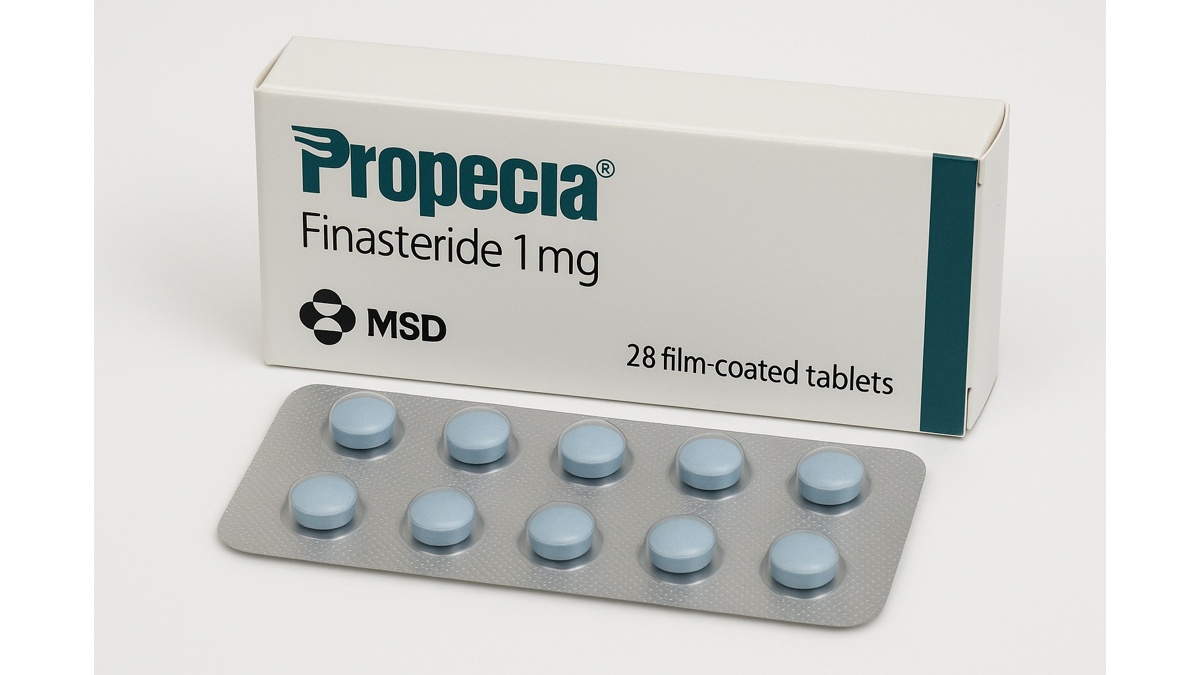
Manufacturer: Various
Known as: Finasteride / Propecia
| Package | Price | Per pill |
|---|---|---|
| 20 pills | $44.42 | $2.22 |
| Package | Price | Per pill |
|---|---|---|
| 20 pills | $30.39 | $1.51 |
Read the instructions carefully
Place an order in a few clicks >>
General Information of Propecia (finasteride)
Propecia (Finasteride) is a prescription oral medication used primarily to treat male pattern hair loss (androgenetic alopecia). It works by inhibiting the type II 5-alpha-reductase enzyme, which converts testosterone to dihydrotestosterone (DHT); excess DHT leads to hair follicle miniaturization in genetically predisposed men. Propecia is typically prescribed in a dose of 1 mg once daily. Always consult your doctor before starting Propecia to ensure it’s appropriate for your situation.
Composition and Active Ingredients
- Active ingredient: Finasteride 1 mg
- Inactive ingredients: common tablet excipients such as lactose monohydrate, microcrystalline cellulose, pregelatinized starch, magnesium stearate, etc.
Pharmacological Action
Finasteride lowers scalp and serum DHT levels, usually by ~50% in sensitive men, slowing or halting progression of balding and, in many cases, partially reversing hair thinning. Studies have shown that noticeable improvement often emerges after at least 3 to 6 months of consistent use.
Research and patient reports in recent years have also highlighted Post-Finasteride Syndrome (PFS) in a subset of users: persistent sexual, cognitive, or psychoemotional side effects that may continue even after discontinuing the drug. The mechanism and true incidence are still under scientific discussion, but FDA and EMA include warnings that PFS is a potential risk.
Indications and Uses
When It Is Prescribed
Propecia is prescribed for:
- Men suffering from androgenetic alopecia, especially in the vertex and mid-scalp areas
- Patients with mild to moderate hair loss, in order to slow progression and possibly improve hair density
It may be used off-label in postmenopausal women under strict supervision in rare cases, but it is not broadly approved for women or children.
Age Considerations
Earlier clinical trials limited use to men aged 18-41 years, but by 2025 many practitioners prescribe finasteride to older men as well; effectiveness tends to be greater when balding is less advanced. The age “41” is not a strict cutoff, but patients must be carefully evaluated regarding potential risks and benefits.
Buy Propecia Online
Price and Current Offers
Many patients compare propecia generic finasteride with brand Propecia. Generic versions are bioequivalent and generally cheaper, but it is important to ensure the pharmacy is licensed.
Ordering and Delivery Conditions
Propecia requires a prescription in the U.S. Telemedicine consultations are commonly used to obtain prescriptions. Generics are available in 1 mg tablet form. Be cautious about sources; ensure authenticity of tablets.
Availability in Pharmacies
Both brand-name Propecia and generics are widely stocked in many pharmacies. The propecia tablets should be dispensed only with medical oversight.
Dosage and Administration
| Patient Group | Recommended Dosage | Frequency | Duration of Treatment |
|---|---|---|---|
| Adult men | 1 mg | Once daily | Long-term use (6-12 months to see effects), then maintenance as directed by physician |
Continuous use is required to maintain benefits; if treatment is stopped, any gained hair may be lost over ~12 months.
Side Effects and Contraindications
Possible Side Effects
Some men experience propecia side effects including decreased libido, erectile dysfunction, reduced ejaculate volume, or mood changes. For many, these resolve after stopping treatment, but in some cases – consistent with reports of PFS – effects may persist beyond discontinuation.
When the Drug Is Contraindicated
- Known hypersensitivity to finasteride or any component of the tablet
- Use in women who are pregnant or who may become pregnant (especially handling crushed or broken tablets), unless prescribed in rare off-label settings
- Not for use in children
Pregnancy and Female Use
While propecia for men remains the main indication, finasteride is not approved for women of childbearing potential. In postmenopausal women, off-label use occurs under close monitoring. Women who are or may become pregnant should avoid exposure.
Monitoring and Additional Considerations
- Prostate-Specific Antigen (PSA): Finasteride lowers PSA levels by about 50%, which can mask early signs of prostate cancer. Doctors often adjust PSA results by doubling the measured value or use baseline PSA prior to treatment for comparison.
- Long-term safety: Studies to 10+ years show continued suppression of hair loss in many users, though individual response varies.
- Post-Finasteride Syndrome (PFS): As above, some users report persistent side effects; practitioners generally warn of this risk.
Can You Take Propecia with Alcohol?
There is no known direct pharmacological interaction between finasteride and alcohol. However, excessive alcohol use can impact hormone balance, liver function, sleep, and nutrition – potentially undermining hair health. Moderate consumption is advisable while on treatment.
Frequently Asked Questions
Does Propecia work?
What are Propecia before and after results like?
How long should I take Propecia for hair loss?
What is the difference between Propecia and Propecia generic?
Are there psychological effects or other long-term risks?
Sources
- Drugs.com: Finasteride (Propecia) – uses, dosage, interactions, and patient information
- Mayo Clinic: Finasteride oral route – indications, precautions, and side effects
- American Academy of Dermatology: Hair loss – diagnosis and treatment, including finasteride therapy
- Cleveland Clinic: Hair loss treatments overview, including finasteride (Propecia)
- NCBI (PMC): Review of finasteride side effects, including persistent symptoms and post-finasteride syndrome (PFS)
